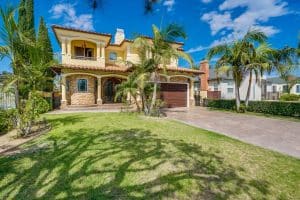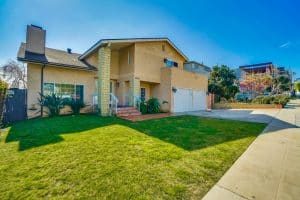Sober Living Resources for Sober Living Montana
Montana, located in the Mountain West region of the United States, is named after the Spanish word “montaña” — which literally means mountain. This enormous state, the nation’s fourth-largest by area, is home to countless mountain ranges. Many of these ranges are considered part of the world-famous Rocky Mountains. However, the state’s eastern half is known for its wide-open prairie terrains and badlands, though even these flat terrains are punctuated by small mountain terrains. The state is bordered by North Dakota, South Dakota, Wyoming, and the Canadian provinces of British Columbia, Alberta, and Saskatchewan.
Montana’s economy is based on agriculture, ranching, and cereal grain farming. A large portion of the land in Montana is farmland, and the cities tend to be small. In fact, the population of Montana is the eighth-smallest of any U.S. state. Much of the population is employed in industries including gas, oil, lumber, coal, and mining. At this time, however, tourism is the fastest growing industry in Montana. Thousands of people visit the state each year to enjoy its natural marvels, which include Yellowstone National Park, Glacier National Park, Big Sky Resort, and Flathead Lake.
However, Montana currently suffers from a significant public health problem. Addiction runs rampant in Montana’s small towns as well as farming communities. A major source of the addiction problem comes in the form of opioids, most notably prescription opioids. In Montana, physicians write an average of 54 opioid painkiller prescriptions for every 100 residents. It should come as no surprise, then, that half of the state’s drug overdoses are opioid overdoses. The other half consists of alcohol-related deaths, crystal meth and cocaine overdoses, and other assorted prescription drug overdoses.
For Montana residents with addiction problems, it can be difficult to recover without outside help. In smaller towns, it can be hard to find other people who have experience recovering from addiction. Individuals who try to control or manage their substance use disorder on their own rarely succeed. Without seeking outside help, most drug and alcohol addictions tend to get progressively worse, wrecking health, breaking apart families, and taking lives.
Fortunately, Montana is home to many sober living houses that offer people with addictions a source of hope. Sober living homes are designed to facilitate long-term sobriety by providing support, structure, and a safe environment for recovery. By taking part in a sober living home in Montana, or even elsewhere, young people with substance addictions can free themselves from the vicious cycle of addiction and rebuild their lives.
What Are Sober Livings
Sober living homes in Montana are residences that facilitate addiction recovery. They are designated clean and sober homes. Staff members enforce recovery house rules, the most important of which is that residents remain drug and alcohol-free. As such, every person living in a sober living house is guaranteed a trigger-free environment. Environmental triggers can be extremely destabilizing for individuals in early sobriety, who are often emotionally vulnerable. By preventing housemates from being exposed to substance abuse, sober living homes significantly decrease the likelihood of relapse.
Sober living homes also provide housemates with opportunities to develop their social support systems. Sober living home residents are more than just roommates — they work together toward the common goal of recovery. To that end, individuals who have been sober for longer periods of time often take on mentorship roles, offering support, advice, and strength. House members keep each other accountable. In fact, the peer support networks that sober living homes offer have been shown to decrease the chances of relapse even years after a person has left. The relationships that residents develop in sober livings often outlast graduation, and these friendships make sobriety both joyful and meaningful.
Sober living homes often take an active role in residents’ recoveries. Many of them offer intensive scheduling and a great deal of structure for residents. Residents with underlying issues, such as mental health disorders or legal problems, can expect to be put in touch with any services they need. All housemates work toward addressing underlying issues, repairing past damage, and working toward new futures. Sober living staff guide residents as they secure jobs, develop new life skills, and face the challenges of early sobriety.
Sober Fun in Montana
The term “sober fun” might sound impossible to individuals who are actively embroiled in addiction. However, for residents and graduates of sober living homes, sober fun becomes very achievable. By taking part in activities in the company of newfound sober friends, any event can become fun and exciting. The coping skills that sober living homes help reinforce make it possible for individuals to approach activities with positivity and open-mindedness.
Opportunities for sober fun in Montana are plentiful. This state of the American West has a touch of wildness that even clean and sober people can appreciate. From its massive unaltered natural spaces to its cities and small towns, Montana inspires creativity and is always open for exploration. Instead of staying in a dark bar night after night, newly sober people in Montana have a wide range of outdoor activities to choose from. Just a few examples of excellent places to explore in sobriety include:
Fly Fish Blue Ribbon Waterways
Montana is famous for its fly fishing. Anglers have been casting lines here for as many years as there are fish in the river! Montana’s bountiful rivers include the Gallatin River, the Blackfoot River, and the Yellowstone Rivers. Not only can visitors enjoy seasonal hatches at a wide variety of rivers and mountain streams, but most also offer beautiful mountain scenery.
Yellowstone National Park
The nation’s first national park, Yellowstone, contains over two million acres that visitors are free to explore. Visitors who enter from the North Entrance in Gardiner, Montana will immediately encounter the Boiling River, followed by the stunning travertine terraces of Mammoth Hot Springs. Visitors who come in from West Yellowstone can enjoy the Norris Geyser Basin, Steamboat Geyser, the Grand Prismatic, and the world-famous Old Faithful.
Lewis and Clark Caverns State Park
This state park is located entirely underground. Visitors here can take a guided tour led by park staff to explore the underground caves. Distinct tours are offered depending on the month and the visitors’ abilities. During the colder month of winter, tour guides offer a special Candlelight Tour. These limestone caverns are filled with bats, tight spaces, and other crawlspaces.
Enjoy Montana’s Hot Springs
Montana has many hot spring locations. The western half of Montana includes many developed hot springs, which feature man-made pools that pipe natural mineral water in. Chico Hot Springs is a historic location, featuring a large open-air pool. Other options include Lolo Hot Springs, near the Idaho border, as well as Quinn’s Hot Springs Resort. Relaxing in sobriety is important — and it’s hard not to feel relaxed while soaking in piping hot mineral water.
The C.M. Russell Museum Complex
Located in Great Falls, Montana, the C.M. Russell Museum is entirely devoted to celebrating the artist Charles M. Russell. Charles M. Russell is sometimes known as the Cowboy Artist. His career spans the end of the 19th century to the early 20th century. Visitors can check out his extensive collection of paintings and artifacts, visit the original Russell studio, and even walk through the Russell Riders Sculpture Garden. For more historical education, the Lewis and Clark Interpretive Center is only a short drive away, providing visitors with more opportunities to learn about regional history.
Glacier National Park
Glacier National Park is sometimes known as the Crown of the Continent. Located in Northwest Montana, this scenic national park is composed of alpine meadows, glistening lakes, mountain ranges, tall waterfalls, thick forests, and even glaciers. It provides opportunities for adventurous exploration as well as relaxing picnics. Camping is available throughout the park’s extensive backcountry, though many stop by for simple day hikes.
Explore a National Forest
Montana is famous for its mountain ranges, but it is also home to 10 different national forests. Together, these forests add up to almost 20 million acres. If you’re visiting Montana, a trek through at least one of these forests is essential. If you’re visiting the university town of Missoula, you’re in luck — the city is encompassed entirely by the Lolo National Forest.
Benefits of Montana Sober Living Houses
Individuals recovering from substance use disorders need to invest as much time as possible. Addiction is not a condition with a “cure.” It is a chronic mental health disorder. However, individuals can learn to live quality lives free from the obsessive cravings that characterize addiction. To do so, it is important to develop a strong social support system, plentiful skills, and a balanced lifestyle. Sober living homes allow residents to stay as long as they need to do so, often for a year or more. Benefits that sober living house residents get to experience include:
Supportive Staff
Staff members have often been through the recovery process themselves, so they are living testament to the fact that recovery is possible. Many staff members and sober living house managers live on-site with residents, so staff members are always available to answer questions, offer emotional support, and share their own experiences. 24/7 staff presence also ensures that house rules are always followed.
Social Support Systems
Perhaps the most critical aspect of life in a sober living home is the peer support that residents get. Addiction, often known as a “disease of loneliness,” tends to make people feel like no one understands them — that they’re the only people in the world who feel the way they do. Living with others in recovery proves that they’re not alone. Housemates learn to rely on one another, keeping each other accountable and offering actionable advice and feedback. Many of the friendships people develop are lifelong, which makes it easy for sobriety to be filled with fun, laughter, and excitement.
Life Skills Training
Sober living home staff recognize that successful addiction recovery involves far more than just quitting drugs and alcohol. Few people want to return to their old lifestyles when they get sober. Sober living homes help residents restructure their lives by teaching crucial life skills that they may have missed out on during years of active addiction. From applying to jobs to conflict resolution, residents grow in countless areas. By the time they graduate, they are more than prepared to live independent and prosperous lives in the outside world.
Transition From Rehab
Many people successfully get sober in sober living facilities. However, sober living houses are also commonly utilized as transitional programs by individuals who have gotten sober in rehab. Research shows that taking part in further recovery-related programs after rehab drastically reduces the likelihood of relapse. Sober livings are one of the most commonly recommended types of aftercare programs, allowing recent rehab graduates to rebuild and develop their lives before venturing off on their own.
Is Montana Sober Living Right For Me?
Montana is home to many quality sober living homes. These homes offer support, structure, and safe, trigger-free environments for individuals in early recovery. Individuals who spent their active addiction years in Montana may benefit most, however, from enrolling in a sober living house outside of Montana. This is because their home state may be associated with too many triggers, from old drinking buddies to neighborhoods that remind one of purchasing drugs. It can be helpful to make an entirely fresh start, develop new habits, and cultivate a new social circle.
Many addicts in Montana flock to California as they begin their recovery journeys. Southern California is the birthplace of a highly lauded type of sober living home: structured sober livings. Structured sober livings provide residents with additional structure and access to recovery resources. Southern California offers familiar mountain ranges as well as enormous cultural diversity. Its thriving recovery community can be found throughout this open-minded and health-conscious city.
Recover From Drug and Alcohol Addiction at Design for Recovery
Design for Recovery is Southern California’s top structured sober living for men. Staff at Design for Recovery are committed to helping residents address their underlying issues, develop new coping tools, and rebuild their lives from the bottom up. No matter how hopeless an individual feels, how devastated their life may seem, recovery is possible at Design for Recovery.
Our community welcomes young men regardless of their history. We firmly believe that recovery is achieved through working together. While supporting each other and holding each other accountable, housemates work hard to develop fundamental values and principles. These include accountability, honesty, integrity, and kindness. Moreover, residents work to develop life skills and plan for their futures. By the time they graduate, the young men at Design for Recovery can expect to be the best version of themselves possible — and our alumni continue to strive forward to make further progress.
If you are ready to put down drugs and alcohol and begin gaining the gifts of recovery, contact us today. Consultations with Design for Recovery staff are both free and entirely confidential.
Frequently Asked Questions
A sober living home is a safe, substance-free residence for people recovering from addiction. It acts as a transitional housing option, bridging the gap between inpatient facilities and the real world. sober homes, usually located in quiet neighborhoods, help individuals reinforce their rehab lessons. They provide a cost-effective living environment and support sobriety. Sober living homes are peer-managed and expect residents to pursue better health and a substance-free life. They strictly enforce rules, with violations leading to eviction. Rules include signing a contract, attending support group meetings or outpatient treatment, and paying rent. Costs vary based on location and services.
The cost of residing in sober living homes in Montana can vary depending on factors such as the location, type of residence, available amenities, and the nature of the program. Monthly expenses range from $2,000 to $10,000. Some homes provide structure rather than a formal program, reducing costs. Utilities may be included or rationed. Rent is typically charged monthly, without requiring upfront payment. Resources like insurance, grants, sliding scale payments, and payment plans can help cover costs.
The length of stay at sober living houses in Montana are not fixed and can vary depending on the individual’s needs and the rules of the house. However, it is commonly advised to spend a minimum of 90 days in treatment and sober living before reintegrating into society.
Entering a sober living in Montana has numerous benefits for individuals in addiction recovery. These include:
- Safe and pressure-free living space
- Supportive environment promoting discipline and sobriety
- Reinforcement of rehab lessons
- Bridge between inpatient care and independent living
- Transition support from treatment to independent life
- Structured environment for regained stability
- Distance from triggers and temptations
- Connection with others in recovery for shared insights
- Job search/placement assistance
- Additional counseling
- Long-term residence option
- Improved physical and emotional well-being
Some sober living houses in Montana allow pets, while others do not. Pet-friendly homes offer benefits such as healing, joy, discipline, life lessons, unconditional love, and stress reduction. However, rules and regulations regarding pets vary by home, and residents must adhere to them if pets are allowed.
Read Further: Sober Living that Allows Pets
Yes, sober living in Montana does help residents find employment. These homes actively support residents in their job search and employment goals. They may require residents to be actively working or seeking employment while residing in the homes. Many sober living homes offer valuable resources and assistance to residents, such as resume writing, job application support, and skill training. Some homes even provide onsite job opportunities for residents as they transition out of the program. By promoting employment, sober living homes aim to help residents meet their financial responsibilities and develop a sense of accountability.
Visiting rules in a sober living home vary. Some homes may prohibit opposite-sex visitors or any drugs/alcohol. Approval is often required in advance, and curfews must be respected. Overnight guests are generally not allowed. Residents must show respect to housemates and staff. It’s important to inquire about specific visitor rules at each recovery home.
Design For Recovery also organizes regular events during which family members are invited to congregate with house members.
The rules regarding cell phones in sober living houses may vary depending on the specific sober living house. At Design For Recovery, we limit cell phone access for residents in the early days of their recovery. This gives them the opportunity to focus on their present circumstances and the present moment, cultivate real relationships with fellow house members, and look inward.
These policies may not necessarily apply to all sober living homes. Therefore, it’s recommended to ask each potential sober living house what their rules are regarding cell phones.
The house rules for sober living homes in Montana may vary, but here are some common guidelines:
- Sobriety: Residents are required to maintain sobriety and abstain from alcohol and drug use while residing in the home.
- Meetings and Activities: Active participation in 12-step meetings, counseling sessions, or other recovery-related activities may be expected.
- Curfew: There might be a set curfew that residents need to adhere to, ensuring a structured routine and promoting responsibility.
- Drug Testing: Random or regular drug testing may be conducted to ensure compliance with the sobriety requirements.
- Chores and Responsibilities: Residents may be assigned household chores and responsibilities to maintain cleanliness and a sense of community.
- Respect for Others: Mutual respect and consideration for fellow residents’ privacy, boundaries, and recovery journeys are typically emphasized.
- Visitors and Guests: Guidelines regarding visitors and guests, such as limitations on visitation hours or prior approval requirements, might be in place.
- Financial Obligations: Residents are expected to pay rent and other associated expenses promptly and fulfill financial obligations.
- Supportive Environment: Creating a supportive and nurturing atmosphere, fostering personal growth, and encouraging peer support and accountability may be part of the house rules.
Staff members also enforce several sober living house rules designed to ensure a safe and healthy environment for residents.
Sober living homes provide a supportive environment for sobriety, offering:
- Substance-free space for real-world responsibilities
- Peer support from individuals with similar experiences
- Community support and encouragement
- Randomized drug and alcohol screenings
- Accountability through house rules
- Job assistance and connections to local employers
- Possible oversight from treatment providers
- Bridge between inpatient care and real-world transition
- Reinforcement of rehab lessons
- Safe space to develop habits and coping mechanisms
Amenities and services vary by sober living homes, so it’s best to inquire about specific offerings at each potential home.
The success rates of men’s sober living in Montana vary based on individual circumstances and dedication to recovery. However, research has shown that staying in a structured and supportive environment like a men’s transitional living significantly increases the chances of maintaining long-term sobriety compared to going directly back to independent living post-treatment.
Scholarships and financial aid are available for sober living. Options include:
- Grants for medical and living expenses
- Financial aid from treatment facilities
- Government grants from the Sober Living Foundation
- Healthcare grants for various medical needs
- No-cost options like halfway house programs
- State and federal funding, such as SAMHSA grants
Scholarship availability varies by program and location, so inquire about specific options at each sober living program.
Staying in a men’s sober living house long-term offers benefits for recovery:
- Smooth transition to daily life
- Ongoing support for lifelong recovery
- Reduces relapse risk by eliminating substances
- Eliminates triggers in early sobriety
- Provides structure and support
- Increases chances of long-term sobriety
- Offers job training and preparation
Benefits may vary by individual and program, so inquire about specific long-term benefits at each men’s transitional living house.
Finding the right sober living home can be challenging. Here are tips to help you:
- Determine your needs: Consider budget, structure, and privacy preferences.
- Research options: Look for local sober living homes and explore their programs and amenities.
- Visit and tour facilities: See if they meet your needs during a visit.
- Consider rules and structure: Look for consistent enforcement and adherence to house rules.
- Seek peer support: Choose homes with a supportive community of individuals with similar experiences.
- Look for job training and programs: Consider homes offering programs to aid long-term recovery.
Availability and offerings may vary, so research multiple options and visit facilities to find the best fit for you.


















